Sega Wat (Spicy Ethiopian Beef Stew)
This post may contain affiliate links. See my disclosure policy.
A thoroughly delicious Sega Wat recipe, the famous Ethiopian beef stew! This spicy beef stew is one of Ethiopia’s most famous and beloved dishes. The depth and complexity of flavor is incredible and this recipe rivals the very best restaurant versions you’ve had!
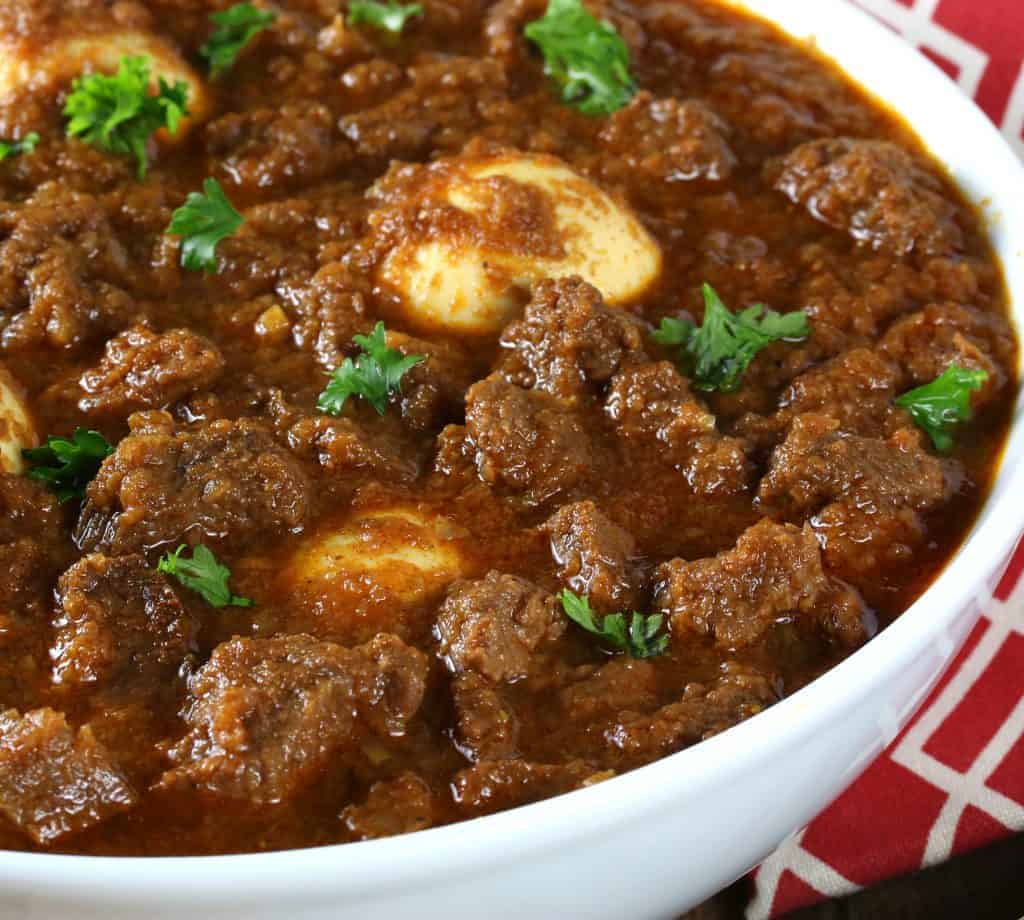
What is Sega Wat?
If you like African food you’ve most likely tried Doro Wat, the spicy chicken stew that Ethiopia embraces as its national dish. Another famous and equally delicious dish is Sega Wat, the beef version of this spicy stew. On restaurant menus you may find a couple of options – Key Sega Wat (spicy) and Alicha Sega Wat (mild). We’re making Sega Wat today and this one is middle of the road in its spiciness so you can add more heat if you prefer.
Sega Wat is traditionally eaten with injera, Ethiopia’s famous fermented flatbread. This spongy pancake-like flatbread is used in place of utensils to scoop the sega wat into your mouth and mop up any remaining bits of sauce.
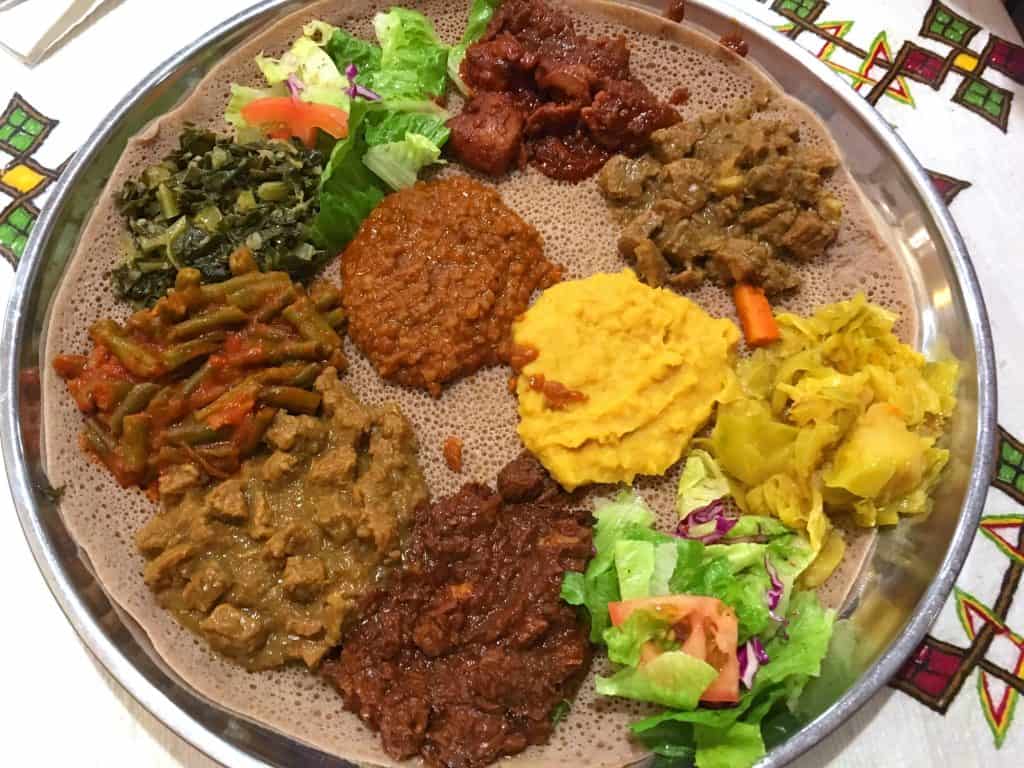
Key Ingredients
As with Doro Wat, the key to an excellent Sega Wat is using the best berbere you can find. Berbere is a fiery, bright red spice blend that Ethiopians pump up to such scorching levels love it’s a wonder they have any taste buds remaining. Most berbere you find outside of Africa is toned down in heat level and that suits me just fine.
The key to an excellent berbere is making it yourself with whole spices that are toasted and ground, which will give this dish maximum flavor. I highly recommend making your own – check out my homemade Berbere.
But if you do use store-bought berbere be sure to get a good amount of it because you’ll need 1/4-1/3 cup of it for this recipe alone. Keep it stored in an airtight glass jar in a dark place and it will keep for a while. Berbere also makes a great rub for meat, poultry, and fish, as well as a seasoning for stews, soups, and vegetables. It’s a great all-purpose spice, so you’ll be able to make good use of this bulk package if you decide to buy versus make your own. The best deal I’ve found for bulk berbere (and it also happens to be organic and a reputable brand) can be found HERE.
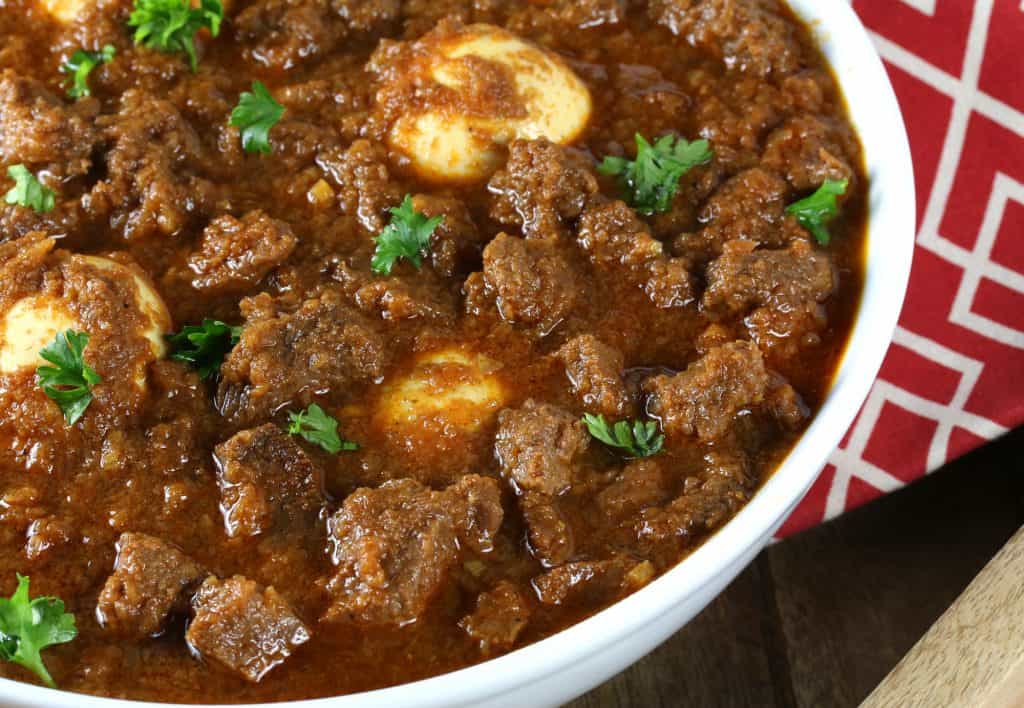
If you’ve never tried Sega Wat, your taste buds are in for a treat. The flavor of this Ethiopian stew is absolutely incredible. And as much as I love Doro Wat, I like Sega Wat even more – the beef adds a wonderfully deep and robust flavor and is sure to win you over!
Now that you’re equipped with Ethiopian berbere and Ethiopian injera, you’re ready to make one of Ethiopia’s most famous popular dishes, Sega Wat!

Sega Wat Recipe
Let’s get started!
Heat 3 tablespoons of niter kibbeh or butter in a heavy pot or Dutch oven. Add the onions and cook, covered, over low heat for 20 minutes, stirring occasionally.
Add the garlic, ginger, and 1 tablespoon niter kibbeh and continue to cook for another 10 minutes, stirring occasionally.
Add the berbere and the 2 remaining tablespoons of niter kibbeh and cook, covered, over low heat for another 10 minutes, stirring occasionally.
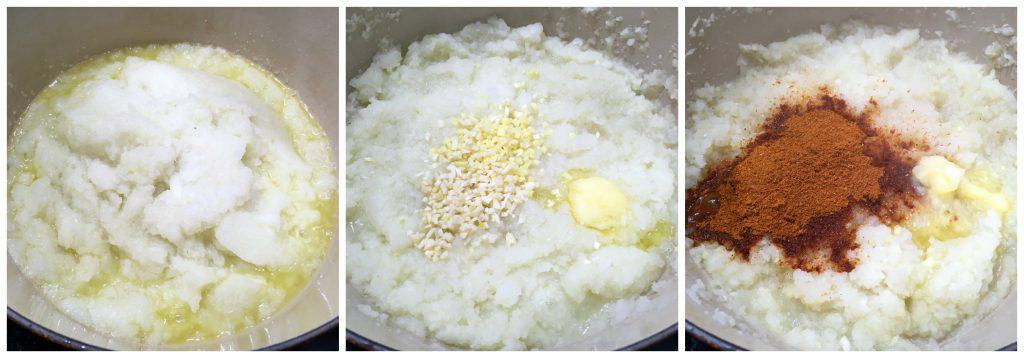
Add the beef, broth, salt and bring to a boil. Reduce the heat to low, cover, and simmer for 45 minutes, stirring occasionally.
Adjust the seasonings, adding more berbere according to taste and heat preference. Add the hard-boiled eggs and simmer on low heat, covered, for another 10 to heat through. Note, while eggs are an intrinsic addition to Doro Wat (the chicken version of this stew), they are not typically added to sega wat, but I personally love the addition.
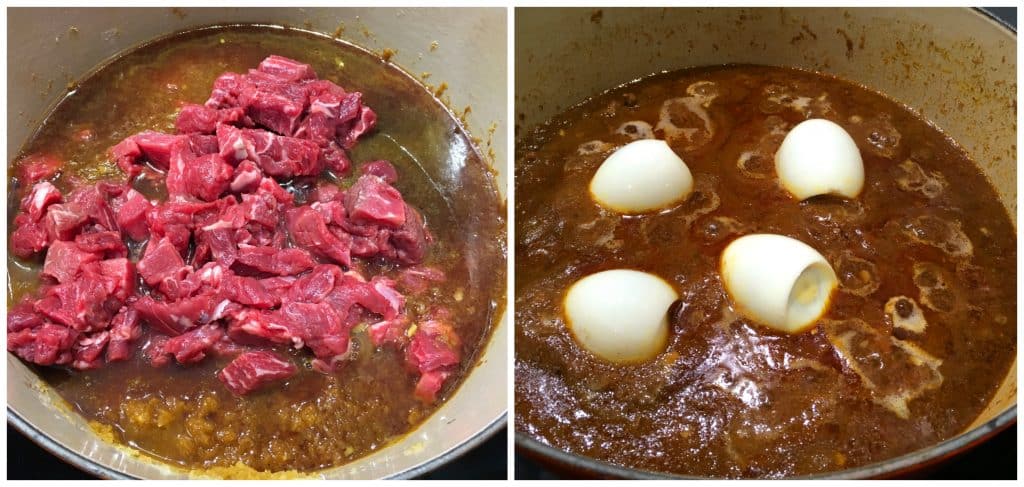
Half or quarter the eggs and arrange on the plates with the stew. Serve hot with Ethiopian injera, bread or rice.
*This stew is even better the next day after the flavors have had more time to meld.
Enjoy!

Be sure to also give my Doro Wat a try!
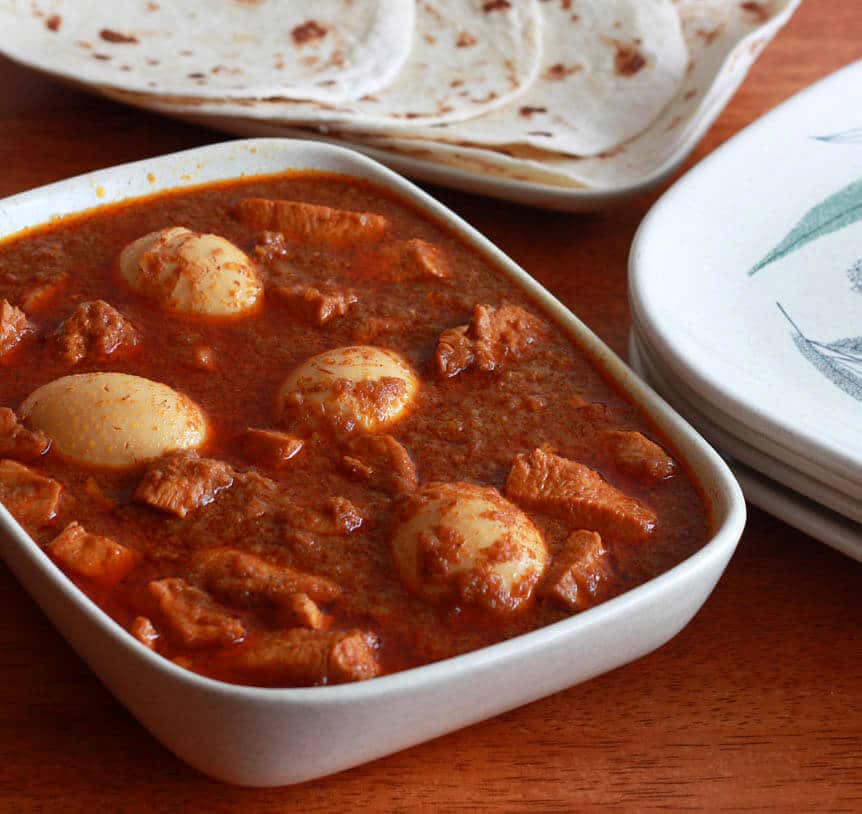
And grab the recipe for authentic homemade Ethiopian injera!
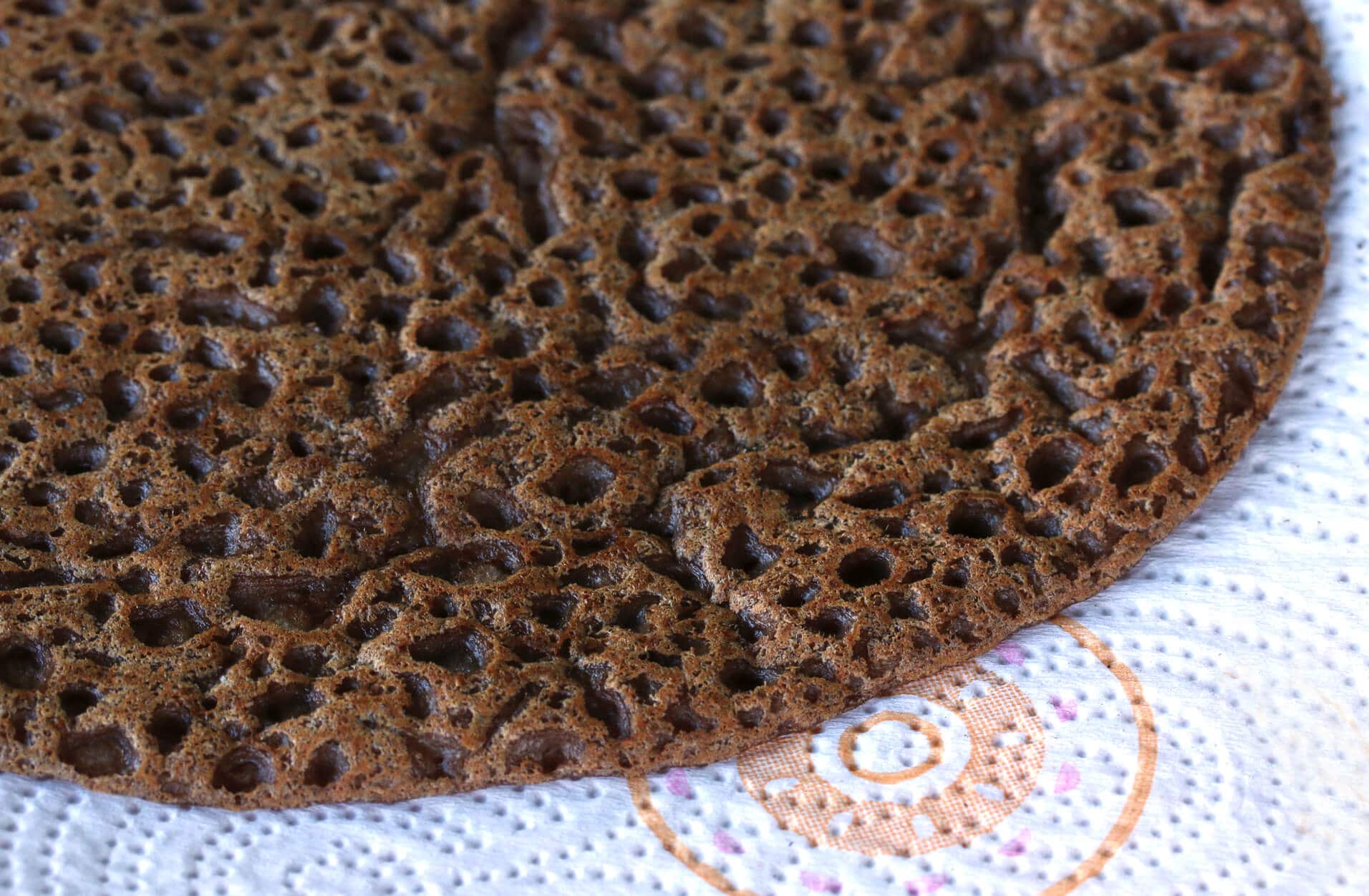
Save This Recipe

Sega Wat (Spicy Ethiopian Beef Stew)
Ingredients
- 2 pounds boneless beef chuck, cut into 1/2 inch cubes
- 6 tablespoons niter kibbeh , divided
- 3 cups chunky pureed onions (pulse in food processor to form a chunky paste)
- 1 1/2 tablespoons minced garlic
- 1 1/2 tablespoons minced fresh ginger
- 1/4 cup berbere spice blend
- Homemade Berbere Recipe ,HIGHLY recommended!
- 1 1/2 teaspoons salt
- 1 cup strong beef broth
- 4 hard-boiled eggs, shelled and pierced all over with a fork 1/4 inch deep (optional: traditionally added to doro wat, the chicken version of this stew, I like adding them to sega wat as well)
Instructions
- Heat 3 tablespoons of niter kibbeh or butter in a heavy pot or Dutch oven. Add the onions and cook, covered, over low heat for 20 minutes, stirring occasionally. Add the garlic, ginger, and 1 tablespoon niter kibbeh and continue to cook for another 10 minutes, stirring occasionally. Add the berbere and the 2 remaining tablespoons of niter kibbeh and cook, covered, over low heat for another 10 minutes, stirring occasionally. Add the beef, broth, salt and bring to a boil. Reduce the heat to low, cover, and simmer for 45-60 minutes, or until the beef is tender, stirring occasionally.
- Adjust the seasonings, adding more berbere according to taste and heat preference. Add the hard-boiled eggs and simmer on low heat, covered, for another 10 to heat through. Half or quarter the eggs and arrange on the plates with the stew. Serve hot with Ethiopian injera, bread or rice.*This stew is even better the next day after the flavors have had more time to meld.
Nutrition
Originally published on The Daring Gourmet February 16, 2018



















Made it for my sister and we loved it. I had leftover spice powder from another recipe. Thank you for including the variations. I appreciate your creativity and seeing things from different angles, alternatives to consider.
This isn’t the first time I’ve encountered disgruntled traditionalists in comments. I suppose you could tag the recipe as a non-traditional version. As a creative, I found it amusing.
I’m so glad you enjoyed it, Laurie, thank you for the feedback! <3
I make a wide variety of different meads. I’ve always loved Tèj, but I’ve never been able to make it with an Ethiopian honey. That is, until this month. It’s absolutely incredible! I wanted to enjoy it with a great Ethiopian meal, so I tried this one. It was so delicious! Thank you for the recipe!
Well done on the homemade Tèj and I’m so glad you enjoyed the sega wat, thank you!
I specifically wanted the traditional recipe without eggs but using a PRESSURE COOKER!!!!!!
my wife an I are vegan but we love the spices used in Ethiopian cuisine so it took some adapting but we managed it. We used green/young jackfruit (canned), the coloring wasn’t as dark but the flavors and mouth feel were remarkable.
Bravo
That’s fantastic, Arthur, I’m happy you enjoyed it and appreciate the feedback about subbing the jackfruit!
Fantastic Recipe. A True Taste Of Africa!!!! I Like It Spicey, So I Add Dried Chilli’s To The Dish. And I Serve With Flat Breads,, Fufu, Jollof Rice, And Plenty Of Ice Cold Beers. Enjoy.
Thank you so much, Tim, I’m thrilled that you enjoyed it!
This was so delicious! We had it at an Ethiopian restaurant a couple of months ago and my husband suggested I try making it myself. Yours was the first recipe that came up and I am so glad I tried it. The flavor is out of this world, we both loved it! Trying your other Ethiopian recipes next!
That’s wonderful, Shaley, I’m so happy you both enjoyed it, thank you!
While the effort commendable it is not authentic to add broth or eggs, ever. We do not use broth in any cooking and boiled eggs ONLY go with doro wat (chicken stew). And never eat with anything other than injera.
I’m just curious, no broth and egg, everything else in the recipe sounds good? Anything else missing?
Alright, Don’t Get Out Of Your Pram Abbey!!! ALL Recipies Are Open To Slight Changes Of Ingredients. Calm Down Girl. Chill
It is nice to hear people enjoy Ethiopian food but, as a native of a country, I have to say that it is disappointing to post recipiences than are not authentic. Hard boiled eggs are for chicken alone, never combined with beef. If you see it in a restaurant in the US then rest assured it is not authentic. But I have to say that I am impressed with the butter recipe. Very authentic. The secret to any Ethiopian food is in the butter
Just relax. No need to get angry over whether an egg goes in a curry or not. There’s bigger issues in this world to get angry about.